Oct 15, 2012
Reminder: Spain’s Green Disaster a Lesson for America
Dale Hurd, CBN News
BARCELONA, Spain—It was just last year that President Obama was touring Solyndra headquarters and telling us green technology was the future:
“The future is here. We are poised to transform the ways we power our homes and our cars and our businesses,” Obama said.
The president said America had better get on board or else fall behind the rest of the world in the growth of renewable or “green” technology.
Spain’s Colossal Failure
One the nations he held up as an example for America’s green technology effort was Spain.
However, President Obama may like Spain’s green technology program, but the Spanish—not so much. One study has declared it a colossal failure.
The Spanish recently threw out their socialist government over their terrible economy and a 22 percent unemployment rate.
Green technology was supposed to be Spain’s path to more jobs and a cleaner more prosperous future. It wasn’t.
“Politicians told us some years ago that they found a new way of investing or doing public investing in a new sector, in the renewable energies, that would create a sort of new economy with new jobs, green jobs, so called green jobs,” Dr. Gabriel Calzada Álvarez, with King Juan Carlos University in Madrid, said.
But what the Spanish got was a big helping of a Solyndra style business debacle: a lot of taxpayer money down the drain and jobs that cost a fortune to create.
A Job Killer
Calzada, an economist, studied Spain’s green technology program and found that each green job created in Spain cost Spanish taxpayers $770,000. Each Wind Industry job cost $1.3 million to create.
“President Zapatero, for example, when he came in to power, said he knew, ‘he knew’ that solar energy was the future,” Calzada said. “He ‘knew’ this, so he put all the public money and investment into this model.”
But Calzada’s study found that for every four jobs created by Spain’s expensive green technology program, nine jobs were lost.
Electricity generated was so expensive that each “green” megawatt installed in the power grid destroyed five jobs elsewhere in the economy by raising business costs.
Unsafe Conditions
Marta Sabina lives on the outskirts of Barcelona in one of Spain’s new green technology apartment buildings.
It has been a nightmare for this mother of three young children. Her toilet uses recycled water with chemicals in it.
She said it’s unsafe for her children and often looks no different from toilet water that hasn’t been flushed.
“A lot of times I am coming to the bathroom and I am pushing all the time because the water is dirty and I don’t know if it’s the kids because they have not pushed or if because it’s the water,” Sabina said. “Sometimes it smells very bad and it’s very dirty and it’s not for kids.”
Sabina has also had to heat her family’s hot water on the stove because the building’s solar water heater didn’t work for three years.
Breaking the Bank
Spain’s green technology dream was costing the nation more than $15 billion a year before the government had to slash it because it had failed and Spain was going broke.
The Obama Administration’s 2007 stimulus package included $80 billion for green jobs.
“Green energy is not ready for prime time,” Seton Motley, president of Less Government, said. “It’s not ready for private sector production.”
“Everything that requires government money means there’s no market for it,” he explained. “Because if there was a market for it, there’d be plenty of private capital to invest in it and people saying, ‘Let’s go forward.’”
The market didn’t like General Motors, which faced bankruptcy. Then Washington came to the rescue. Uncle Sam bought 500-million shares of General Motors, which have since lost $15 billion in value.
“I can’t think of, off the top of my head, a bigger loser than GM, as far as most money in one place that’s going down the tubes,” Motley said.
Environmental Dream Buster
The Spanish could have taught the Americans a thing or two about government money down the tubes.
Spain spent billions on an environmental dream that helped make their economy worse and added to the nation’s already crushing government debt.
And now Spain’s future is looking more like what Greece is facing.
Spain Admits “Green Jobs” Program A Disaster (2010 link)
Eventually, no matter hard one tries to wish it away, reality will smack you in the face. Hard.
As predicted was inevitable, today the Spanish newspaper La Gaceta runs with a full-page article fessing up to the truth about Spain’s “green jobs” boondoggle, which happens to be the one naively cited by President Obama no less than eight times as his model for the United States. It is now out there as a bust, a costly disaster that has come undone in Spain to the point that even the Socialists admit it, with the media now in full pursuit. [...]
La Gaceta boldly exposes the failure of the Spanish renewable policy and how Obama has been following it. The headline screams: “Spain admits that the green economy as sold to Obama is a disaster.”
According to the Spanish government, the policy has been such a failure that electricity prices are skyrocketing and the economy is losing jobs as a result (emphasis added):
The internal report of the Spanish administration admits that the price of electricity has gone up, as well as the debt, due to the extra costs of solar and wind energy. Even the government numbers indicate that each green job created costs more than 2.2 traditional jobs, as was shown in the report of the Juan de Mariana Institute. Besides that, the official document is almost a copy point by point of the one that led to Calzada being denounced [lit. “vetoed"] by the Spanish Embassy in an act in the U.S. Congress.
The presentation recognizes explicitly that “the increase of the electric bill is principally due to the cost of renewable energies.” In fact, the increase in the extra costs of this industry explains more than 120% of the variation in the bill and has prevented the reduction in the costs of conventional electricity production to be reflected on the bills of the citizens.
[Translation of Spanish article provided by Chris Horner]
Despite these facts, which quite frankly have been known for quite some time, the Obama administration is still planning to move ahead with its own policy based explicitly on the Spanish one. As Horner states:
That fight [over the “green economy” policy] begins anew next week with the likely Senate vote on S.J. Res. 26, the Murkowski resolution to disapprove of the Environmental Protection Agency’s attempt to impose much of this agenda through the regulatory back door without Congress ever having authorized such an enormous economic intervention.
Just as with the ObamaCare boondoggle that was rammed into law despite its (a) known problems that are only now being admitted to, (b) real costs that are only now becoming evident, and (c) unacceptability to the vast majority of Americans, Obama is going full steam ahead with this “green economy” nonsense. Regardless of facts or reality, this administration is dead set on re-creating America in the image it likes best (i.e. European social democracy), regardless of the costs. So long as we end up with all the bells and whistles that are the hallmarks of our European betters (e.g. universal health care, carbon taxes, depleted military, enhanced welfare state, overwhelming government controls of the economy, sufficiently apologetic “transnationalist” foreign policy), the actual results of that transformation are unimportant. We may end up an economic basket case a la Greece, but hey, at least we’ll have all the nanny-state accouterments necessary to commiserate with the cool European kids.
It’s gotten to the point where pointing out that the emperor has no clothes only results in naked orgies of Utopian spending. This cannot end well.
H/T Tom Nelson
Oct 12, 2012
Antarctic consensus “flips”. Warmer water means “more” sea ice!
By Joanne Nova
In a move of Olympian audacity, Seth Borenstein keeps a straight face and shamelessly shifts to pretending that more Antarctic sea-ice fits their climate change theory. Yet again climate models fail to predict things in advance, they only do the post modern type of prediction - the bury-my-bewilderment type, after the fact. Once more, nothing can disprove the theory of man-made climate catastrophe.
The oceans are warming, but that now means less sea ice in the Arctic, and more sea-ice in the Antarctic. Of course!
Shifts in wind patterns and the giant ozone hole over the Antarctic this time of year - both related to human activity - are probably behind the increase in ice, experts say. This subtle growth in winter sea ice since scientists began measuring it in 1979 was initially surprising, they say, but makes sense the more it is studied.
The only point of science is to predict things. But when alarmist predictions turn out to be wrong, Borenstein and co don’t adjust the theory, they pretend post hoc that the new results “fitted” all along, and radiate collective amnesia about the hundreds of times they “experts” predicted the opposite.
Antarctic sea ice hit record highs in late September. Skeptics pointed out that out, and asked why alarmists didn’t mention it, and news outlets ignored it. It’s taken the PR team three long weeks to come up with the big idea that really, this doesn’t show the models are wrong for the 40th time. In PR it helps to pretend your scientists are not surprised.
“Antarctic sea ice hasn’t seen these big reductions we’ve seen in the Arctic. This is not a surprise to us,” said climate scientist Mark Serreze, director of the NSIDC.
No surprise? But look at what they used to say:
The IPCC Experts in AR4 prediction (thanks to Bishop Hill)
“In 20th- and 21st-century simulations, antarctic sea ice cover is projected to decrease more slowly than in the Arctic (Figures 10.13c,d and 10.14),”
In other words, they didn’t predict the outcome, and they didn’t get the cause right either, but as long as they can pretend it’s man-made they can keep telling us off in the press, and asking for larger grants.
See also IPCC #15.4.4where they discuss the impact of decreasing sea ice, but not of the possibility it might increase.
Many predictions are about the ice shelves, not the sea-ice specifically, but we have to ask what conditions could warm both the seas and the ice shelves, and yet create record levels of sea ice? How did these predictions pan out?
USGS (2010):
Ice shelves are retreating in the southern section of the Antarctic Peninsula due to climate change. This could result in glacier retreat and sea-level rise if warming continues
Could sea ice increase, and ice shelves melt?
British Antarctic Survey:
A thaw of Antarctic ice is outpacing predictions by the U.N. climate panel and could in the worst case drive up world sea levels by 2 meters (6 ft) by 2100, a leading expert said on Wednesday.
Byrd Polar Research Center at Ohio State University:
Most models predict that both precipitation and temperature will increase over Antarctica with a warming of the planet.
Al Gore, Jan 2012
What happens to the rest of the world as that frozen water is released, at ever increasing rates, as a result of the rising temperatures caused by climate change?
[In 1988] Scientists expected that as climate change accelerated, Antarctica would be one of the fastest warming areas of the planet. This prediction has proven true
Latest ICEsat estimates thanks to Zwally et al:
“During 2003 to 2008, the mass gain of the Antarctic ice sheet from snow accumulation exceeded the mass loss from ice discharge by 49 Gt/yr”
Latest GRACE satellite data shows Antarctica is gaining ice mass also.
Watch how they dishonestly shift gear, never admitting they were completely wrong, instead they “transmute” the cause. They said Antarctic sea ice would decrease, instead it hit record highs, but now, it’s still “man-made”, it’s just the evil CFC’s again:
Climate change has created essentially a wall of wind that keeps cool weather bottled up in Antarctica, NASA’s Abdalati says.
And the wind works in combination with the ozone hole, the huge gap in Earth’s protective ozone layer that usually appears over the South Pole. It’s bigger than North America.
It’s caused by man-made pollutants chlorine and bromine, which are different from the fossil fuel emissions that cause global warming. The hole makes Antarctica even cooler this time of year because the ozone layer usually absorbs solar radiation, working like a blanket to keep the Earth warm.
In 2007 “experts” suggested that the winds helped to melt the ice:
Some researchers are suggesting that the strengthening of the westerlies may be playing a role in the collapse of ice shelves along the Antarctic Peninsula.
Steve Goddard comments: It is the new kind of ice which is created by heat, rather than cold.
Which scientist predicted that the Antarctic would cool?
It was Henrik Svensmark. His theory points out that the Antarctic is unlike any other place on Earth. It’s so blindingly white, that it’s the only place where an increase in cloud cover lowers the albedo (which means the region absorbs more energy, and reflects less). That means when the rest of the world warms due to lowered cloud cover, the Antarctic will cool, and vice versa. I don’t know if cloud cover explains what is happening at the moment, perhaps Svensmark’s theory doesn’t help here either, but at least he made a prediction that can be checked.
What happens to sea levels?
And again, in the real world, they can’t just mess with one factor and keep everything else the same if global “pollution” means more Antarctic sea ice now, what does that mean for all the sea level disasters we’re told to expect?
REFERENCES:
Zwally, H. Jay; Li, Jun; Robbins, John; Saba, Jack L.; Yi, Donghui; Brenner, Anita; Bromwich, David Mass, 2012: Gains of the Antarctic Ice Sheet Exceed Losses, Surv Geophys
Oct 02, 2012
Dr Tim Ball: Obama’s Democratic Convention Climate Change Comments Fail Fact Checking
Dr Tim Ball
UPDATE: A February survey of 4,778 farmers across the nation’s Corn Belt found that while roughly two-thirds believe the climate is changing, just 8 percent believe human activities are the primary cause
Tom Nelson
Public opinion: Most farmers see climate change but can’t see humans causing it—10/05/2012—www.eenews.net
A new crop of opinion polls suggests many U.S. farmers believe the climate is changing, but few lay the blame on man-made greenhouse gas emissions. Fewer still favor policies to cut greenhouse gas emissions. And many are turned off by even the mention of “climate change,” which they consider a highly politicized phrase.
A February survey of 4,778 farmers across the nation’s Corn Belt found that while roughly two-thirds believe the climate is changing, just 8 percent believe human activities are the primary cause. Preliminary results from a similar poll conducted in Mississippi, North Carolina, Texas and Wisconsin in 2009 show 40 to 50 percent of commercial farmers in those states don’t believe climate change has been scientifically proved, while roughly 70 percent believe climate shifts will have little effect on crop yields.
Even in tiny Yolo County, Calif., a solidly Democratic outpost in a blue state, just 35.2 percent of 162 farmers surveyed by researchers at the University of California, Davis, agreed that human activities are “an important cause” of climate change. And respondents were equally divided when asked whether climate change would benefit or harm agriculture on a global scale. Perhaps unsurprisingly, polls also show few growers are willing to accept measures designed to combat climate change.
Farmers and probably sailors agree with the over 33,000 scientists and nearly 10,000 PhD who signed the Petition project rejecting consensus science. Of course this group has been dismissed as a few kooks by the environmental reporters and rent seeking college professors and researchers at the Labs benefiting from the tens of BILLIONS of dollars of government largesse to give the environmentalists and politicians with other agendas the cover to pretend its all about saving the planet.
---------
Tim Ball
Many organizations “fact-check” economic claims of politicans at US election Conventions, but climate facts need scrutiny. In his Democratic convention speech President Obama said;

Enlarged
“And yes, my plan will continue to reduce the carbon pollution that is heating our planet-because climate change is not a hoax. More droughts and floods and wildfires are not a joke. They are a threat to our children’s future and in this election you can do something about it.”
What is carbon pollution? Carbon, is a solid not a greenhouse gas. Do you mean CO2, a naturally occurring gas essential to plant life, and not a pollutant? It’s unclear because you say, incorrectly, it’s causing climate change. Projected warming and climate change due to CO2 only occurs in predetermined Intergovernmental Panel on Climate Change (IPCC) computer models that exclude major mechanisms and whose projections are consistently wrong.
What does “climate change is not a hoax” mean? Nobody ever said it was a hoax. The hoax is the science and Reports of the IPCC.
Disconnected comments continue. Nobody ever said droughts, floods and wildfires are a joke. A real joke is the prefix “more” because all these events are within natural variability. It’s the same mythology used about increased number of hurricanes.
Most peer-reviewed solar activity science is excluded from the IPCC Reports. There are three solar activities, but only changes in electromagnetic radiation (insolation) are included. They exclude the Milankovitch Effect of changing orbit, tilt and precession of the equinox and Svensmark’s cosmic explanation of solar effects on temperature.
The IPCC said insolation explained over 50 percent of temperature change up until 1950, but since then they’re over 90 percent certain human produced CO2 is the cause. This result was a product of their computer models.
A British Broadcasting Corporation (BBC) story linked recent weather with that of the Little Ice Age (LIA). They said;
“Astronomers have reported that the Sun is at its dimmest for almost a century.”
The BBC identified two previous coolings caused by reduced solar activity, the Dalton (1795-1823) and Maunder (1645-1715) Minimums.

Cycle 24 likely will not reach 75 total sunspots. Two experts, Mausami Dikpata of the National Center for Atmospheric Research and NASA Solar Physicist David Hathaway predicted over 150 sunspots.
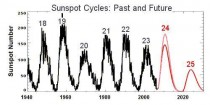
Original caption: Past sunspot cycles up to the spring of 2006 are shown in black.The two future sunspot cycle predictions are shown in red (Hathaway) and pink (Dikpata).
The current level of 75 sunspots for Cycle 24 is their projection for Cycle 25. Only two periods, the Dalton Minimum and the Maunder Minimum had equal or lower readings.
The IPCC ignored the sunspot and temperature relationship because there was no explanatory mechanism. But one appeared in 1991 and in 1996 Friis-Christensen, Director of the Danish National Space Institute said,
“All these consistent scientific results illustrate that the current climate models used to predict future climate are lacking important parts of the physics”
The mechanism appeared more fully in 1997 as the Cosmic Theory (CT) defined by Svensmark and Friis-Christensen. The 2001 IPCC Report mentioned it briefly, but it was omitted in the 2007 Report.
The CT is now confirmed. Low cloud amounts vary as cosmic rays are varied by strength of the Sun’s magnetic field. Clouds are the shade in the global greenhouse. Sunspots aren’t the cause, but a manifestation of changes in the Sun’s magnetic field. The most recent confirmation appeared on Sept 6, 2012 and says,
“Given the wide, and perhaps at times excessive, interest in tying carbon dioxide to climate, there has been relatively little work investigating the solar-climate connection.”
Mr President, your comments are scientifically meaningless. With your access to qualified researchers one must conclude they are political. You said people can do something about climate change. That’s false. German Physicist and meteorologist Klaus-Eckhart Plus said about climate change,
“There’s nothing we can do to stop it. Scientifically it is sheer absurdity to think we can get a nice climate by turning a CO2 adjustment knob.”
He said this after educating himself about IPCC science, which apparently directs your views.
“Ten years ago I simply parroted what the IPCC told us. One day I started checking the facts and data – first I started with a sense of doubt but then I became outraged when I discovered that much of what the IPCC and the media were telling us was sheer nonsense and was not even supported by any scientific facts and measurements. To this day I still feel shame that as a scientist I made presentations of their science without first checking it.”
World leaders making presentations before checking the science and facts is more shameful.
Oct 01, 2012
New Weather-Shifting Climate Cycle Revealed
You know El Nino - now meet the Pacific Centennial Oscillation
WHOI scientist Kris Karnauskas and colleagues have found evidence for a natural 100-year cycle that shifts Pacific Ocean temperatures and rearranges rainfall and weather patterns around the globe. (Tom Kleindinst, Woods Hole Oceanographic Institution)
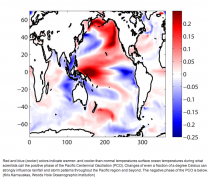
Enlarge Image
Red and blue colors indicate warmer- and cooler-than-normal temperatures surface ocean temperatures during what scientists call the positive phase of the Pacific Centennial Oscillation (PCO). Changes of even a fraction of a degree Celsius can strongly influence rainfall and storm patterns throughout the Pacific region and beyond. The negative phase of the PCO is below. (Kris Karnauskas, Woods Hole Oceanographic Institution)
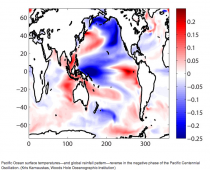
Enlarge Image
Pacific Ocean surface temperatures - and global rainfall patternreverse in the negative phase of the Pacific Centennial Oscillation. (Kris Karnauskas, Woods Hole Oceanographic Institution
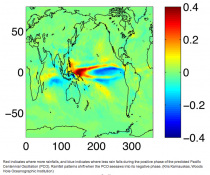
Enlarge Image
Red indicates where more rain falls, and blue indicates where less rain falls during the positive phase of the predicted Pacific Centennial Oscillation (PCO). Rainfall patterns shift when the PCO seesaws into its negative phase. (Kris Karnauskas, Woods Hole Oceanographic Institution)
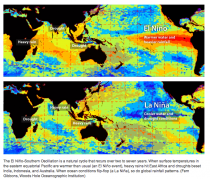
Enlarge Image
The El Nino-Southern Oscillation is a natural cycle that recurs over two to seven years. When surface temperatures in the eastern equatorial Pacific are warmer than usual (an El Niño event), heavy rains hit East Africa and droughts beset India, Indonesia, and Australia. When ocean conditions flip-flop (a La Nina), so do global rainfall patterns. (Fern Gibbons, Woods Hole Oceanographic Institution)
By Elizabeth Halliday
Scientists have uncovered evidence for another natural cycle that, like El Nino and La Nina, shifts Pacific Ocean winds and currents and rearranges rainfall and weather patterns around the globe. The newly detected cycle recurs every 100 years, less frequently than the two-to-seven year El Nino-Southern Oscillation. But its existence, if confirmed, offers another fundamental cog to understand the ocean-atmosphere machinery that regulates worldwide rain, droughts, wildfires, floods, landslides, fisheries, and storms.
The new cycle, called the Pacific Centennial Oscillation, was reported in the September 2012 issue of Journal of Climate. It provides a deeper understanding of how natural cycles may interact with manmade global warming to produce far-reaching climate impacts emanating from the Pacific region.
“We base many of our conclusions about regional aspects of climate change on instrumental records we’ve obtained over only about 150 years, and so we might just be scratching the surface in terms of what is going on naturally over centennial timescales,” said Kris Karnauskas of Woods Hole Oceanographic Institution. He is lead author of the new study, with colleagues Jason E. Smerdon and Richard Seager of Columbia University’s Lamont-Doherty Earth Observatory and Jesús Fidel Gonzalez-Rouco of the Universidad Complutense de Madrid.
With a little more than a century of data gathered with ships, moorings, and satellites, scientists have become well acquainted with El Nino and La Nina, in which water temperatures cycle like a seesaw, becoming warmer and cooler over the course of several years in the eastern tropical Pacific off the coast of South America. Warmer waters in the eastern Pacific (El Niño) disrupt the atmosphere typically found over the cool waters, triggering a reduction or reversal of the westward-blowing trade winds. That, in turn, has far-reaching reverberations: It shifts evaporation patterns over the ocean that transfer moisture to the atmosphere; it reshuffles atmospheric circulation, generating atypical weather from Australia to America; it diminishes upwelling of cooler, nutrient-rich waters that nourish fisheries. La Nina, in which the eastern Pacific gets abnormally cooler, has similar, but opposite impacts.
A new pattern emerges
Understanding Pacific Ocean phenomena such as the El Nino-Southern Oscillation helps forecasters predict how Earth’s climate will respond to global warming. But to investigate patterns that might be at play on longer timescales, Karnauskas and colleagues were interested in how tropical Pacific Ocean temperatures behaved if viewed over 1,000 years, rather than several decades.
To do that, they harnessed the power of computer models used to make projections of future climate. The models weave together a variety of interacting physical processes in the atmosphere, ocean, ice, and land that combine to create climate conditions. The complexity of these models requires intensive computing power and long run times; so the models are usually used to simulate only the last and upcoming centuries - to ensure that the models reliably replicate the past and then to see how they predict future climate scenarios.
Karnauskas and colleagues analyzed three separate global climate models that simulated thousands of years of past ocean and atmospheric dynamics on Earth, with or without human activities factoring into the results. By removing the din of human industrialization, scientists can hear the natural signals of baseline conditions in nature.
All three models produced a strikingly similar pattern: In a 100-year cycle, waters in the western Pacific near Indonesia and in the northeastern Pacific, near the west coast of the United States and around Alaska and Kamchatka in Russia, all became warmer than normal; waters in the eastern tropical Pacific near South America and in the northwestern Pacific (near China and Japan) and the southwestern Pacific (near northern Australia) became cooler. That pattern flip-flopped, then returned roughly each century.
Coral confirmation
The model simulations also revealed important climatic impacts from this Pacific Centennial Oscillation. The pool of warmer water in the eastern tropical Pacific triggered atmospheric waves radiating in both directions toward Earth’s poles, which significantly altered wind patterns over the North and South Pacific. These atmospheric changes strongly influenced storm tracks through mid-latitudes on both sides of the equator, as well as water conditions that affected coastal fisheries in California and Alaska. The Pacific Centennial Oscillation also greatly altered rainfall in the tropics, with important ramifications for agriculture and water supplies in some of the world’s most vulnerable regions, Karnauskas said.
Of course, the model results are theoretical. Karnauskas said he hoped the finding will motivate scientists who study past climates to take the next step: searching for records of past Pacific Ocean temperatures lodged in coral skeletons and seafloor sediments to verify the Pacific Centennial Oscillation predicted by the models. Fortunately, many of the areas that appear to be affected by the Pacific Centennial Oscillation host abundant reefs that may be queried to see if the 100-year cycle exists, and if so, where in that cycle we are today.
This research was funded by the Reuben F. and Elizabeth B. Richards Endowed Fund.
Sep 28, 2012
Changes in the Arctic and Antarctic - opposite sign records for satellite era
Scientific Alliance
The media and NOAA have been obsessed with the arctic minimum for the satelite era set with the help of the continuing warm Atlantic Multidecadal Oscillation and a major arctic storm that compressed broken ice.
The ice is recovering on schedule as winter approaches. Meanwhile the Antarctic set a new record high for sea ice extent. Don’t expect to see this in the major mainstream media.
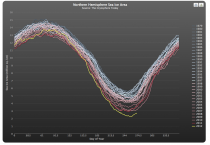
Enlarged
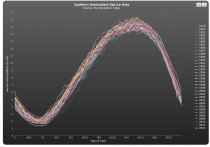
Enlarged
------------
Scientific Alliance
Every year, sea ice forms and melts in the Arctic. The summer melt covers a wide area, and the minimum area occurs sometime during September. From now on, freezing takes place increasingly rapidly as the days shorten and temperatures drop. Looked at over extended periods, there will be trends towards more or less summer melting. So it has always been, and so it always will be. But since 1979 the extent of Arctic ice has been measured and recorded and the current trend is for greater melting. Indeed, by most reckoning, this year has seen a record low for sea ice extent. The question is, how worried should we be?
There is, of course, no simple answer. Believers in the likelihood of dangerous global warming in decades to come say we should be very worried and predict that the Arctic will be ice-free in summer before long. But there are others who see this as part of a longer-term cycle, about which we can do little and which will have at worst only modest consequences. Indeed, some point out that the Earth is overdue for a return to an Ice Age, which would have an enormous negative impact on our species as well as many others.
Greater loss of ice in summer is also not simply caused by higher average temperatures as a direct effect of higher carbon dioxide levels in the atmosphere. For a start, there has been no increase in average temperature this century, despite ever-rising CO2 levels. Although the Arctic appears to be warming faster than average, as the enhanced greenhouse hypothesis predicts, other expected effects are not apparent. In particular, the projected warming of the upper troposphere in the tropics has not really materialised, and the Antarctic ice cap has largely continued to grow.
Another factor which has often been cited is black carbon (soot) deposited on the ice, leading to greater absorption of solar radiation and more melting. Some scientists have suggested that this accounts for a large part of the observed melting and overall warming. But weather patterns also have their part to play. Changes in wind direction and the strength or temperature of ocean currents can make a large difference.
The consequences of loss of summer ice are not clear cut, either. Because all Arctic ice is sea ice, its loss makes no difference to sea level, unlike melting of the Greenland and Antarctic ice caps, which are on land. But shrinking Arctic ice cover also affects the Earth’s albedo, allowing more heat to be absorbed and contributing to further warming (in the summer only, with ice inevitably reforming during the long polar winter).
Whatever the impacts, what is still not clear is the extent to which this melting is unprecedented. We should remember that satellite measurement only started in 1979, just 33 years ago. Before that, we only have memory, diaries and records of other local observations. It is undeniable that the summer melt is greater than seen by most people in their lifetimes, but there is no direct measurement of the situation much before that.
To set this in context, what we do know is that the world has seen an irregular rise in temperature since the late 19th Century, as it emerged from what is known as the Little Ice Age. It is highly likely that Arctic summer ice was more extensive at this time, but we also know that considerable warming occurred during the early part of the 20th Century, with the 1930s being a particularly warm decade, followed by a gradual drop in temperature until the most recent warming trend started in the mid-1970s. Satellite observation now makes it possible to plot the extent of ice quite accurately, but before that no-one knew for sure.
Going further back, the Roman and Medieval Warm Periods are well documented. It was during the MWP that Vikings established viable colonies on the coast of Greenland and reached the east coast of North America. The prevailing view is that their settlements were abandoned or wiped out when the warm period ended and the downward trend of temperatures began, leading to the Little Ice Age. It seems almost certain that Arctic sea ice would have melted to a greater extent than normal during the warmer times, but we simply can’t quantify this.
What we also don’t know is what drove the climatic variation between these warmer and cooler periods. It was clearly neither large scale use of fossil fuels nor changes in agricultural practice. Solar cycles almost certainly played some role, with observers having recorded the correlation between weather patterns and sunspots over many years.
Whatever the causes, the same drivers are most certainly still at work today, making it virtually impossible to quantify the contribution of increased CO2 with any confidence. We know that, all else being equal, higher levels in the atmosphere should lead to higher average temperatures, but the whole highly polarised and largely unconstructive debate is about the extent of this change. Is there simply the modest impact calculated by spectroscopists or is there a positive feedback as the warmer air carries more water vapour?
We may not know the answer, but for more than a decade the warming effect of carbon dioxide has been cancelled out by other factors, possibly including the negative feedback of increased cloud formation (itself perhaps boosted by greater penetration of cosmic rays into the atmosphere in times of low solar activity, according to the Svensmark hypothesis). Arctic sea ice is melting (and the Antarctic ice cap growing) over a period when there is no trend in average temperatures.
If the ice-free Arctic summers come to pass soon, as some are predicting, the fact is that we will have to live with them, because there really is nothing we can reliably do in the short to medium term to alter the trend, particularly as climate is still so poorly understood. For all practical purposes, adaptation rather than mitigation must be the primary focus of policy.
|











